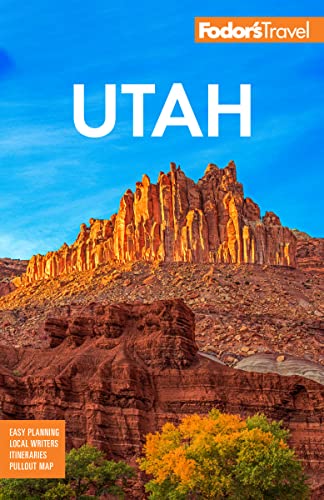Utah’s Five Glorious National Parks, 7 Days
It takes considerable gumption and resources to fly and drive from much of the United States to reach the iconic desert of southern Utah. This itinerary will help you see the highlights and navigate the considerable ground you’ll cover by car and foot.
Days 1 and 2: Zion National Park
(3 hours from McCarran Airport in Las Vegas)
Start early from Las Vegas, and within three hours you’ll be across the most barren stretches of desert and marveling at the bends in the Virgin River gorge. Just past St. George, Utah, on I–15, take the Route 9 exit to Zion National Park. Spend your afternoon in the park—if you're visiting in February through November, the National Park Service bus system does the driving for you on Zion Canyon Scenic Drive (in fact, when the bus is running, cars are not allowed on the drive).
For a nice introductory walk, try the short and easy Weeping Rock Trail. Follow it along the Emerald Pools Trail in Zion Canyon itself, where you might come across wild turkeys and ravens. Before leaving the park, ask the rangers to decide which of Zion’s two iconic hikes is right for you the next day—the 1,488-foot elevation gain to Angel’s Landing or river wading along the improbably steep canyon called the Narrows. Overnight at Zion Lodge inside the park (book well in advance or call for last-minute cancellations), but venture into the bustling gateway town of Springdale for dinner and a peak into an art gallery or boutique. Try Bit & Spur for tasty Southwestern food.
Start at dawn the next day to beat the crowds and heat if you’re ascending Angel’s Landing (allow three to four hours).
Day 3: Bryce Canyon National Park
(2 hours from Zion)
It’s a long 85 miles from Zion to Bryce via Route 9 (the scenic Zion–Mount Carmel Highway), particularly as traffic must be escorted through a 1.1-mile-long tunnel. Canyon Overlook is a great stopping point, providing views of massive rock formations such as East and West Temples. When you emerge, you are in slickrock country, where huge petrified sandstone dunes have been etched by ancient waters. Stay on Route 9 for 23 miles and then turn north onto U.S. 89 and follow the signs to the entrance of Bryce Canyon National Park.
Start at Sunrise Point. Check out Bristlecone Loop Trail and the Navajo Loop Trail, both of which you can easily fit into a day trip and will get you into the heart of the park. Listen for peregrine falcons deep in the side canyons, and keep an eye out for a species of prairie dog that only lives in these parts. If you can’t stay in the park (camping or The Lodge at Bryce Canyon are your options), overnight at Ruby's Inn, near the junction of routes 12 and 63, or the full-featured Bryce Canyon Grand Hotel across the street; both are on the park's free shuttle route.
Day 4: Capitol Reef National Park
(2½ hours from Bryce Canyon)
If you can, get up early to see sunrise paint Bryce's hoodoos, then head out on the spectacular Utah Scenic Byway–Route 12. Route 12 winds over and through Grand Staircase–Escalante National Monument. Boulder’s Hell’s Backbone Grill, for example, may be the best remote restaurant you’ll find in the West, and you don’t want to bypass Fruita’s petroglyphs and bountiful orchards in the late summer and fall.
At the intersection of routes 12 and 24, turn east onto Route 24 toward Capitol Reef National Park. The crowds are smaller here than at other national parks in the state, and the scenery is stunning. Assuming it's still daylight when you arrive, hike the 1-mile Hickman Bridge Trail, stop in at the visitor center, open until 4:30 (later in the spring through fall), and view pioneer and Native American exhibits, talk with rangers about geography or geology, or watch a film. Nearby Torrey is your best bet for lodging and you can get a tasty pizza to enjoy with a microbrew and gorgeous red rock views from the Rim Rock Patio.
Days 5–7: Moab, Arches, and Canyonlands National Parks
(2½ hours from Capitol Reef to Canyonlands)
Explore Capitol Reef more the next morning. An easy way to do this is to drive the 10-mile Capitol Reef Scenic Drive, which starts at the park Visitor Center. When you leave, travel east and north for 75 miles on Route 24. If you want a break after about an hour, stop at the small Goblin Valley State Park. Continue on Route 24 to I–70 and turn east toward Colorado.
Take Exit 182 south onto U.S. 191, proceeding about 19 miles to Island in the Sky Road. Make sure you have water, food, and gas, as Canyonlands National Park offers no services, with the exception of water at The Needles visitor center year-round and the Island in the Sky visitor center seasonally. Be sure to follow the drive out to Grand View Point to look down on the convergence of the Colorado and Green rivers. Along the way, Mesa Arch is a half-mile walk and offers a sneak preview of what to expect at Arches. More ambitious individuals should hike the mysterious crater at Upheaval Dome, which is a steep 1-mile round-trip hike. Whether you plan to explore Canyonlands further the next day or move onto Arches National Park, backtrack to U.S. 191 and turn right for the final 12-mile drive into Moab, a good base camp for both parks.
Build your Arches itinerary around hikes to Delicate Arch (best seen at sunrise to avoid the crowds), Landscape Arch, or a guided hike in the Fiery Furnace.
You can raft the Colorado River from Moab or bike the Slickrock Trail.Or, explore Needles District of Canyonlands (about 90 minutes south), viewing petroglyphs on Route 279 (Potash Road), and driving along the Colorado River north of town to Fisher Towers.




